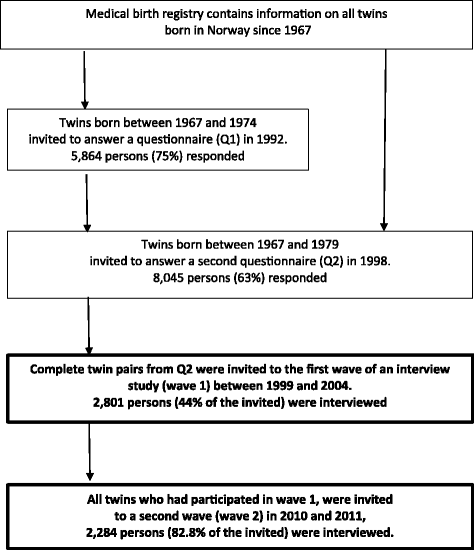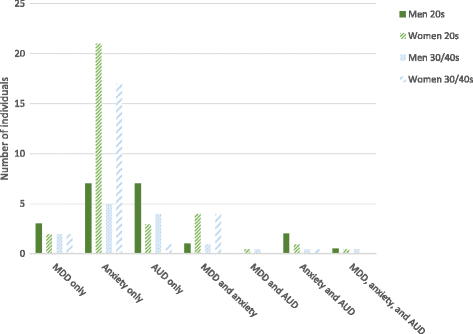Prevalence and stability of mental disorders among young adults: findings from a longitudinal study
- PMID: 29530018
- PMCID: PMC5848432
- DOI: 10.1186/s12888-018-1647-5
Prevalence and stability of mental disorders among young adults: findings from a longitudinal study
Abstract
Background: Mental disorders often have onset early in life, contribute substantially to the global disease burden, and may interfere with young people's ability to complete age-relevant tasks in important developmental periods. However, knowledge about prevalence and course of mental disorders in young adulthood is sparse. The aim of the current study was to estimate prevalence and stability of mental disorders from the twenties to the thirties/forties.
Methods: DSM-IV mental disorders were assessed with the Composite International Diagnostic Interview in two waves (1999-2004 and 2010-2011) in 1623 young adult Norwegian twins (63.2% women, aged 19-29 years in wave 1).
Results: In wave 1, the 12-month prevalence of any mental disorder among people in the twenties was 19.8% (men) and 32.4% (women), anxiety disorders: 9.6% (men) and 26.7% (women), anxiety disorders excluding specific phobias: 2.5% (men) and 6.9% (women), major depressive disorder (MDD): 4.4% (men) and 7.2% (women), and alcohol use disorder (AUD): 8.7% (men) and 4.4% (women). The prevalence of any mental disorder decreased from the twenties to the thirties/forties. This was due to a decrease in AUD and specific phobias. Anxiety disorders in the twenties predicted anxiety disorders and MDD ten years later, even when controlling for the association between these disorders in the twenties. MDD in the twenties predicted MDD ten years later. At both ages, two-week and 12-month prevalence estimates differed markedly for MDD - indicating an episodic course.
Conclusions: Common mental disorders are highly prevalent among young adults in the twenties, and somewhat less prevalent in the thirties/forties. Those who suffer from one mental disorder in the twenties are at considerably increased risk for suffering from a disorder ten years later as well. This may have significant implications for young people's ability to attain education, establish a family, and participate in occupational life.
Keywords: Health surveys; Mental disorders; Prevalence; Stability; Young adulthood.
Conflict of interest statement
Ethics approval and consent to participate
Participants provided written informed consent. The name of the ethics review board that approved of our study is “The regional committee for medical and health research ethics, South East D”. (Reference number: 2010/767).
Consent for publication
Not applicable.
Competing interests
The authors declare that they have no competing interests.
Publisher’s Note
Springer Nature remains neutral with regard to jurisdictional claims in published maps and institutional affiliations.
Figures


References
-
- Wang PS, Aguilar-Gaxiola S, Alonso J, Angermeyer MC, Borges G, Bromet EJ, Bruffaerts R, de Girolamo G, de Graaf R, Gureje O, et al. Use of mental health services for anxiety, mood, and substance disorders in 17 countries in the WHO world mental health surveys. Lancet. 2007;370(9590):841–850. doi: 10.1016/S0140-6736(07)61414-7. - DOI - PMC - PubMed
-
- GBD 2015 Disease and Injury Incidence and Prevalence Collaborators Global, regional, and national incidence, prevalence, and years lived with disability for 310 diseases and injuries, 1990–2015: a systematic analysis for the global burden of disease study 2015. Lancet. 2016;388(10053):1545–1602. doi: 10.1016/S0140-6736(16)31678-6. - DOI - PMC - PubMed
-
- Alonso J, Angermeyer MC, Bernert S, Bruffaerts R, Brugha TS, Bryson H, de Girolamo G, Graaf R, Demyttenaere K, Gasquet I, et al. Prevalence of mental disorders in Europe: results from the European study of the epidemiology of mental disorders (ESEMeD) project. Acta Psychiatr Scand Suppl. 2004;420:21–27. - PubMed
Publication types
MeSH terms
Supplementary concepts
Grants and funding
LinkOut - more resources
Full Text Sources
Other Literature Sources
Medical

